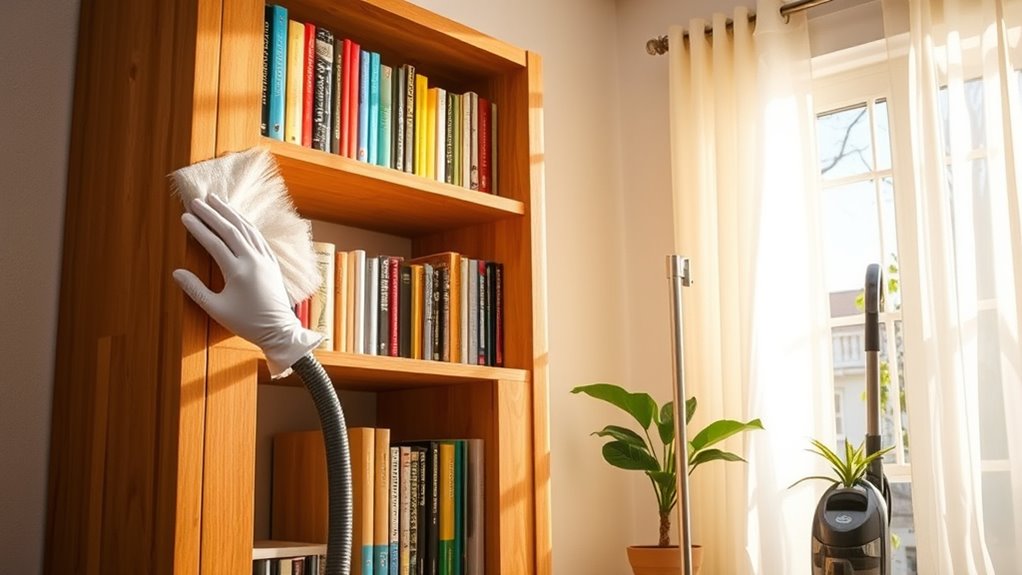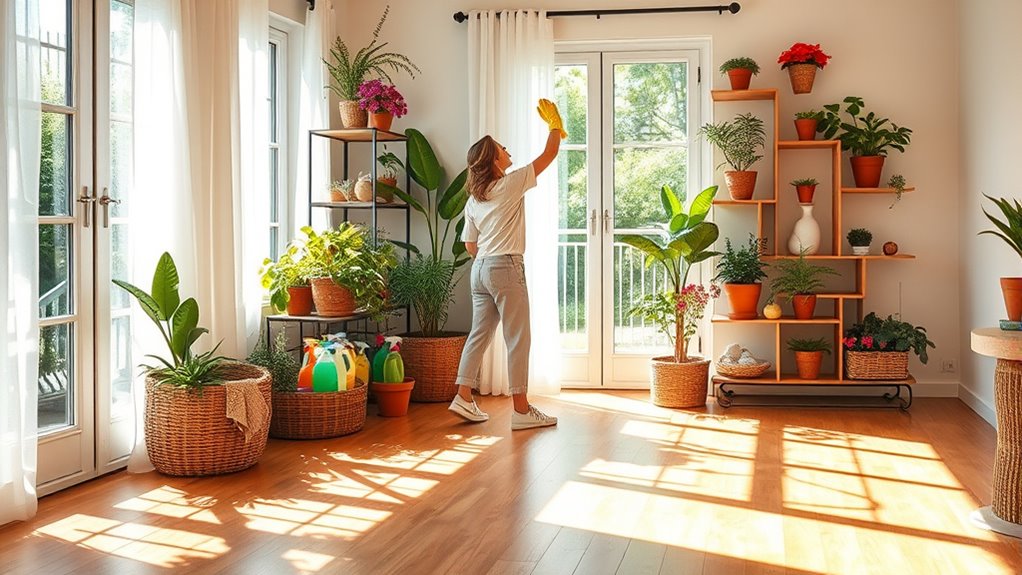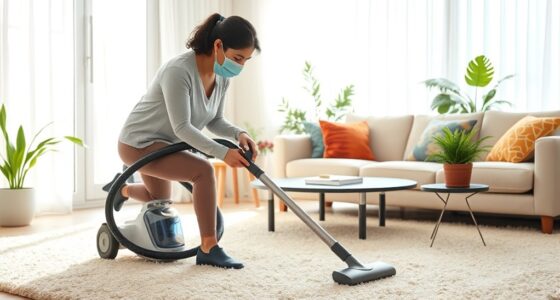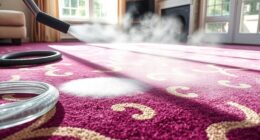To keep your home allergen-free, focus on key seasonal cleaning tasks. Change air filters every three months, or more often if you have pets. Deep clean carpets to remove dust and allergens, and make certain upholstery is vacuumed and steamed to eliminate hidden irritants. Choose hypoallergenic cleaning products to reduce chemical sensitivities. By consistently addressing these cleaning tasks, you can create a healthier indoor environment. Find out more ways to enhance your home’s air quality.
Key Takeaways
- Change air filters every three months to reduce allergens and improve indoor air quality, increasing frequency if pets are present.
- Deep clean carpets regularly to remove dust, pet dander, and embedded allergens that can trigger allergies.
- Vacuum and steam clean upholstery to eliminate dust mites and allergens, especially in high-traffic areas.
- Use hypoallergenic cleaning products to minimize respiratory irritation and maintain a healthier living environment.
- Implement these cleaning tasks seasonally to ensure consistent allergen control and promote a cleaner home.

As the seasons change, it’s the perfect time to refresh your living space with some seasonal cleaning tasks. You might not realize it, but your home can become a haven for allergens if you don’t take the time to maintain it properly. One of the first things you should tackle is air filter maintenance. You may have heard that changing your air filters regularly is essential, but have you considered how often you actually do it? Generally, it’s wise to replace them every three months, but if you have pets or live in a particularly dusty area, you might want to do it even more frequently. Clean air filters can substantially improve your indoor air quality, reducing allergens that can trigger sneezing, coughing, or even asthma attacks.
As seasons shift, remember to prioritize air filter maintenance to keep allergens at bay and improve indoor air quality.
Next up is carpet deep cleaning. Your carpets can trap dust, pet dander, and other allergens, making it vital to give them some extra attention during your seasonal cleaning. If you’ve got kids or pets, you know how easily dirt and stains accumulate. Renting a carpet cleaner or hiring a professional service can make a world of difference. Not only will it help to remove stubborn stains, but it’ll also eliminate the allergens lurking deep within those fibers. Make sure to allow your carpets to dry completely after cleaning, as moisture can lead to mold growth—another allergen you definitely want to avoid.
Additionally, don’t forget about your upholstery. Just like carpets, your couches and chairs can harbor dust mites and allergens. Give them a good vacuum and consider using a steam cleaner if you can. This is especially important if you’ve got upholstered furniture in high-traffic areas. Regular attention to these surfaces can keep your home feeling fresh and allergy-free.
Lastly, take a moment to review your cleaning supplies. Opt for hypoallergenic products whenever possible, and avoid those filled with harsh chemicals. These can irritate your respiratory system and contribute to your allergy problems. Regular use of hypoallergenic products can help create a healthier living environment by minimizing additional allergens in your home. Keeping your home clean and allergen-free doesn’t have to be a formidable task. By focusing on air filter maintenance, carpet deep cleaning, and keeping your upholstery in check, you can create a healthier living environment. So roll up your sleeves, and get started on these essential seasonal cleaning tasks. Your body will thank you!
Frequently Asked Questions
How Often Should I Clean My Air Filters?
You should clean your air filters every one to three months, depending on your environment and usage. Regular air filter maintenance is vital for keeping your indoor air quality high. If you have pets or allergies, consider cleaning them more frequently. Always check the manufacturer’s recommendations for specific guidance. By staying on top of your cleaning frequency, you’ll guarantee your system runs efficiently and reduces airborne pollutants in your home.
What Are Common Indoor Allergens to Watch For?
Imagine your home as a castle, where hidden invaders lurk in the shadows. Dust mites and mold spores are two common foes. Dust mites thrive in warm, humid areas, nesting in your bedding and upholstery, while mold spores can sprout in damp corners. Keeping a vigilant eye on these allergens is essential. Regular cleaning and maintaining low humidity will help you defend your castle and maintain a healthier living environment.
Can Seasonal Cleaning Help With Pet Allergies?
Yes, seasonal cleaning can definitely help with pet allergies. By regularly vacuuming and dusting, you reduce pet dander that accumulates in your home. Don’t forget to wash pet bedding and your own linens often. Additionally, addressing seasonal mold growth is essential, as it can also trigger allergies. Keeping your home clean and well-ventilated helps minimize these allergens, making it easier for you to breathe and feel comfortable in your space.
Is Professional Cleaning Necessary for Allergy Prevention?
Professional cleaning isn’t strictly necessary for allergy prevention, but it can substantially enhance your cleaning routines. They target allergy triggers like dust, pet dander, and mold more effectively than typical methods. If you struggle with persistent allergies, hiring professionals might be worth it. They use specialized equipment and techniques that you might not have, ensuring your space is as allergen-free as possible. Ultimately, combining both approaches can provide the best results.
How Can I Tell if My Cleaning Products Are Allergen-Free?
To tell if your cleaning products are allergen-free, look for eco-friendly products that prioritize ingredient transparency. Start by checking labels for clear lists of ingredients; avoid those with vague terms like “fragrance.” Research brands that openly share their formulations and certifications. You can also seek products labeled hypoallergenic or free from common allergens. Finally, consider reaching out to manufacturers for detailed information on their ingredients and allergen testing practices.
Conclusion
By tackling seasonal cleaning tasks, you’re not just tidying up your space; you’re creating a sanctuary free from allergens. Think of your home as a canvas—every sweep and scrub adds a layer of protection against unwanted guests like dust and pollen. So, roll up your sleeves and embrace this opportunity to breathe easier. A clean home is a happy home, and you deserve to enjoy every moment in your allergen-free oasis.









